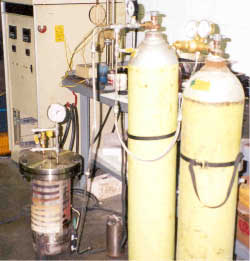Pressurized, Accelerated Life Testing
Abrasion Testing
Accelerated Life Testing
Chemistry Laboratory
Computer Modeling
Salt Spray Testing
Density
Electrical Properties
Electron Microscopy
Experimental Foundry
Failure Analysis
Hardness Laboratory
Heat Treatment Studies
Light Microscopy
Lubrication Testing
Machine Shop
Materials Databases
Mechanical Testing
Metallography
Paint & Coatings
Product Testing
Rolling Mill
Thermal Testing
ACCELERATED LIFE TESTING
ACCELERATED LIFE TESTING
Touchstone performs corrosion testing and accelerated life testing of virtually any material or device. Among the tests offered are:
- Cathodic Disbondment (ASTM G 80, G 95)
- Cleveland Condensing Humidity (ASTM D 4585)
- Corrosion Potential (ASTM G 69)
- Fluorescent UV (ASTM G 53)
- Paint & Coatings Tests
- Pressurized, Accelerated Life Testing
- Pressurized Testing of Heat Exchangers (Radiators, Evaporators and Condensers)
- Test Panel Evaluation (ASTM D 1654)
- Water Resistance and Humidity (ASTM D 870, ASTM D 2247)
SALT FOG AND SALT SPRAY TESTING
- CASS – Copper Accelerated Acetic Acid Salt Spray (ASTM B 368)
- Salt Spray (Salt Fog) (ASTM B 117)
- ASTM G85 Tests
Customized Environment
Pressurized, Accelerated Life Testing of Polymeric Materials
For a prompt reply and quotation on any test, e-mail info@trl.com or call 304-547-5800.

Touchstone built multiple test apparati to test various types of organic polymer materials with exposure to the following test media at pressures to 100 psi and temperatures up to 300 deg F. In most cases dry nitrogen has been used as a cover gas, although testing has been performed with a hydrogen sulfide atmosphere. Other atmospheres are possible including; Methanol, CO2 gas, Water, Diesel fuel, Oil well condensate, H2S gas, Methane gas, Drilling muds, HCl (34%), and Crude oil. Samples are exposed for a specified period after which they are inspected and mechanically tested.
Pressurized SWAAT Testing
The standard practice in the manufacture of brazing sheet is to produce a coil of sheet for plant trials. A group of heat exchangers are produced during this trial and evaluated to determine the performance of the units in various ways including static burst, cyclic pressurization (fatigue), SWAAT corrosion, and thermal flow. The pressurized sheet fixture was developed to allow pressurized SWAAT testing of candidate material prior to plant manufacturing trials to determine whether the brazing sheet is unusually susceptible to corrosion before the expensive trials are undertaken.
The test coupon consists of a 3.5″ disc of brazing sheet that has been formed into a cup using an Olsen cup tester to simulate the extreme cold work effect of stamping, for instance. After forming the test specimen is brazed following conventional procedures and then installed in the test fixture. The fixture can then be pressurized to simulate use conditions (100 to 400 psi) typically using either N2 or He gas. After placing in a SWAAT test cabinet and pressurizing, the fixture is monitored until a drop in pressure occurs indicating a failure. The specimen can then be removed and evaluated metallographically. This system allows evaluation of experimental or production trial lots of sheet without the necessity of actually manufacturing heat exchangers and collapsing the time-to-market for a new product.. If the SWAAT life is acceptable the next step is to product actual parts for evaluation.

